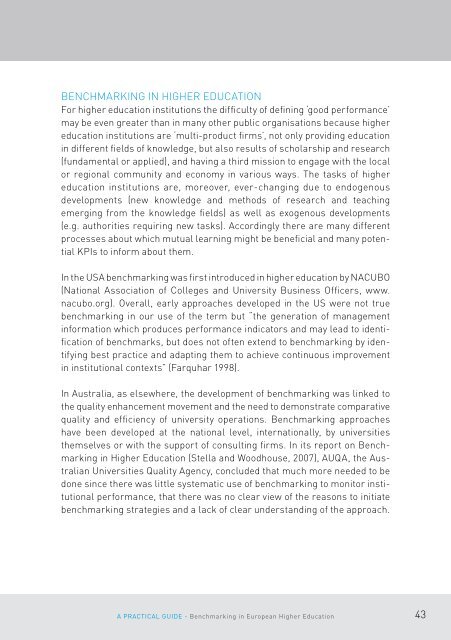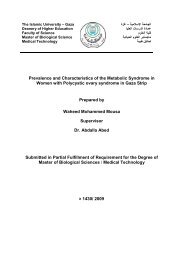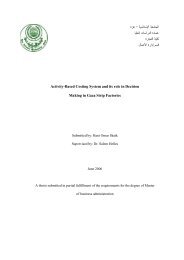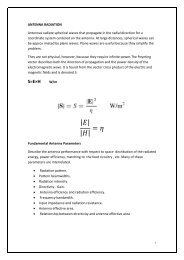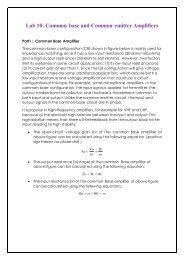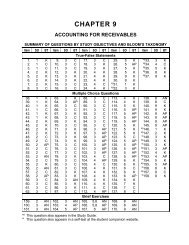A prActicAl guide Benchmarking in european Higher education
A prActicAl guide Benchmarking in european Higher education
A prActicAl guide Benchmarking in european Higher education
Create successful ePaper yourself
Turn your PDF publications into a flip-book with our unique Google optimized e-Paper software.
<strong>Benchmark<strong>in</strong>g</strong> <strong>in</strong> higher <strong>education</strong><br />
For higher <strong>education</strong> <strong>in</strong>stitutions the difficulty of def<strong>in</strong><strong>in</strong>g ‘good performance’<br />
may be even greater than <strong>in</strong> many other public organisations because higher<br />
<strong>education</strong> <strong>in</strong>stitutions are ‘multi-product firms’, not only provid<strong>in</strong>g <strong>education</strong><br />
<strong>in</strong> different fields of knowledge, but also results of scholarship and research<br />
(fundamental or applied), and hav<strong>in</strong>g a third mission to engage with the local<br />
or regional community and economy <strong>in</strong> various ways. The tasks of higher<br />
<strong>education</strong> <strong>in</strong>stitutions are, moreover, ever-chang<strong>in</strong>g due to endogenous<br />
developments (new knowledge and methods of research and teach<strong>in</strong>g<br />
emerg<strong>in</strong>g from the knowledge fields) as well as exogenous developments<br />
(e.g. authorities requir<strong>in</strong>g new tasks). Accord<strong>in</strong>gly there are many different<br />
processes about which mutual learn<strong>in</strong>g might be beneficial and many potential<br />
KPIs to <strong>in</strong>form about them.<br />
In the USA benchmark<strong>in</strong>g was first <strong>in</strong>troduced <strong>in</strong> higher <strong>education</strong> by NACUBO<br />
(National Association of Colleges and University Bus<strong>in</strong>ess Officers, www.<br />
nacubo.org). Overall, early approaches developed <strong>in</strong> the US were not true<br />
benchmark<strong>in</strong>g <strong>in</strong> our use of the term but “the generation of management<br />
<strong>in</strong>formation which produces performance <strong>in</strong>dicators and may lead to identification<br />
of benchmarks, but does not often extend to benchmark<strong>in</strong>g by identify<strong>in</strong>g<br />
best practice and adapt<strong>in</strong>g them to achieve cont<strong>in</strong>uous improvement<br />
<strong>in</strong> <strong>in</strong>stitutional contexts” (Farquhar 1998).<br />
In Australia, as elsewhere, the development of benchmark<strong>in</strong>g was l<strong>in</strong>ked to<br />
the quality enhancement movement and the need to demonstrate comparative<br />
quality and efficiency of university operations. <strong>Benchmark<strong>in</strong>g</strong> approaches<br />
have been developed at the national level, <strong>in</strong>ternationally, by universities<br />
themselves or with the support of consult<strong>in</strong>g firms. In its report on <strong>Benchmark<strong>in</strong>g</strong><br />
<strong>in</strong> <strong>Higher</strong> Education (Stella and Woodhouse, 2007), AUQA, the Australian<br />
Universities Quality Agency, concluded that much more needed to be<br />
done s<strong>in</strong>ce there was little systematic use of benchmark<strong>in</strong>g to monitor <strong>in</strong>stitutional<br />
performance, that there was no clear view of the reasons to <strong>in</strong>itiate<br />
benchmark<strong>in</strong>g strategies and a lack of clear understand<strong>in</strong>g of the approach.<br />
A Practical Guide - <strong>Benchmark<strong>in</strong>g</strong> <strong>in</strong> European <strong>Higher</strong> Education<br />
43


